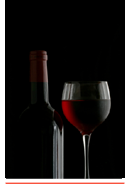

|
Ring in the New Year with a glass of bubbly.
Where there are celebrations of any kind, a bottle of bubbly is never far behind. Why is that? Let me take you on a tour through history. About 350 years ago, in a small abbey in France, there lived a monk named Pierre (Dom Perignon) who devoted his life to making high quality still white table wine out of red grapes. Technology, however, at the time was such that once the bubbles stopped forming at the top of the vat (CO2 being the bubbles and a by-product of fermentation), the winemaker assumed that the fermentation had finished. What they did not realize at the time was in the cool climate of Champagne, the yeast would go dormant because of the cold before the process was complete. Once the fermentation was believed to have finished, the monks would put it in vats and ship the majority of it to England. The wine, unlike Port, would not have to be stabilized because the distance between the northern portion of France and the southern part of England did not warrant it. When the wine arrived in England, they would bottle it and put it in their cellars, but they would do one more dangerous thing to it. Since the English quite enjoyed the sweet taste in their wine, they would usually add sugar to the wine when they bottled it. Come spring, when the temperature would rise, theyeast would re-activate, build pressure in the bottle and would from time to time either explode in the cellar or in the person's face when they tried to open it. The English loved this sweet, frothey wine that they would enjoy at any celebration they could, however, they would soon come to realize that they would need a stronger bottle. The English designed a special bottle, with thick glass and a half round in the bottom to withstand the 70 to 90 PSI that was contained within it. Once safety was no longer a concern, they looked towards the French to refine the product. A 27 year old widow by the name of Barbe-Nicole Clicquot-Ponsardin (La Grande Dame), cut holes in her kitchen table, stuck the bottles in the holes and slowly turned and twisted the bottles until the sediment was all at the neck of the bottle. She then stuck the bottle, upsidedown in a freezing brine, opened the bottle, let the frozen plug fly out, filled it with some reserved wine and plugged it with a cork. Once that was done, she put some wire around the cork so it would not fly out of the bottle. The end product took hold in the Cafes and Playhouses of England and because of CO2s ability to carry alcohol straight to the bloodstream, it played a matchless role at parties and celebrations. Cheers and enjoy responsibly, Jason Ernst |
Producer Laurent-Perrier of France Alphonse Pierlot, a cooper and bottler founded the house of A. Pierlot & Cie. in 1812. The house's current name is derived from the second owner, Eugene Laurent (who was bestowed the company by Pierlot) and his wife and widow Mathilde Emilie Perrier. It is located in Tours-sur-Marne in the Champagne region of France and is to this day, the largest independent family owned house in Champagne. Amongst being the first house to reintroduce the brut nature (no added dosage) concept to a new generation in 1980, they were also the first to use stainless steel tanks in their production. They pride themselves on not only being innovative, but also maintaining close relationships with their growers, enabling them to secure the best grapes for production of their sparkling wine. Cellar-master, Alain Terrier, ensures that each bottle exhibits great freshness, finesse and elegance and has been described as "wines of pleasure" by current owner Bernard de Nonancourt. Laurent-Perrier is the only house in Champagne to have received the Royal Warrant of HRH The Prince of Whales.Alphonse Pierlot, a cooper and bottler founded the house of A. Pierlot & Cie. in 1812. The house's current name is derived from the second owner, Eugene Laurent (who was bestowed the company by Pierlot) and his wife and widow Mathilde Emilie Perrier. It is located in Tours-sur-Marne in the Champagne region of France and is to this day, the largest independent family owned house in Champagne. Amongst being the first house to reintroduce the brut nature (no added dosage) concept to a new generation in 1980, they were also the first to use stainless steel tanks in their production. They pride themselves on not only being innovative, but also maintaining close relationships with their growers, enabling them to secure the best grapes for production of their sparkling wine. Cellar-master, Alain Terrier, ensures that each bottle exhibits great freshness, finesse and elegance and has been described as "wines of pleasure" by current owner Bernard de Nonancourt. Laurent-Perrier is the only house in Champagne to have received the Royal Warrant of HRH The Prince of Whales. If you are looking for a great bubbly for your occasion, you can be sure that Laurent-Perrier will deliver a refined product at a reasonable price. N/V Brut Retail price $49.75 This pale gold colored blend of Chardonnay, Pinot Noir and Pinot Meunier exhibits delicate and complex aromas of citrus and white fruit. On the palate it is fresh and easy to drink with full fruit flavors, good balance and has a lengthy finish with a hint of mineral. Looking at the bubbles coming from the bottom and side of the glass, you will see that they are fine and rise in a regular bead, qualities that re-assure you that it was made in the traditional method. Drink this refreshingly delicate Champagne as an aperitif, as a companion with light seafood or with berries for dessert. |

